
A | B | C | D | E | F | G | H | CH | I | J | K | L | M | N | O | P | Q | R | S | T | U | V | W | X | Y | Z | 0 | 1 | 2 | 3 | 4 | 5 | 6 | 7 | 8 | 9
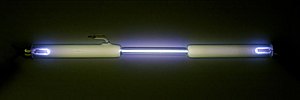 Oxygen-filled discharge tube glowing purple. | |||||||||||||||||||||||||||||||
| Oxygen | |||||||||||||||||||||||||||||||
|---|---|---|---|---|---|---|---|---|---|---|---|---|---|---|---|---|---|---|---|---|---|---|---|---|---|---|---|---|---|---|---|
| Allotropes | O2, O3 (ozone) and more (see Allotropes of oxygen) | ||||||||||||||||||||||||||||||
| Appearance | gas: colorless liquid and solid: pale blue | ||||||||||||||||||||||||||||||
| Standard atomic weight Ar°(O) | |||||||||||||||||||||||||||||||
| Abundance | |||||||||||||||||||||||||||||||
| in the Earth's crust | 461000 ppm | ||||||||||||||||||||||||||||||
| Oxygen in the periodic table | |||||||||||||||||||||||||||||||
| |||||||||||||||||||||||||||||||
| Atomic number (Z) | 8 | ||||||||||||||||||||||||||||||
| Group | group 16 (chalcogens) | ||||||||||||||||||||||||||||||
| Period | period 2 | ||||||||||||||||||||||||||||||
| Block | p-block | ||||||||||||||||||||||||||||||
| Electron configuration | [He] 2s2 2p4 | ||||||||||||||||||||||||||||||
| Electrons per shell | 2, 6 | ||||||||||||||||||||||||||||||
| Physical properties | |||||||||||||||||||||||||||||||
| Phase at STP | gas | ||||||||||||||||||||||||||||||
| Melting point | (O2) 54.36 K (−218.79 °C, −361.82 °F) | ||||||||||||||||||||||||||||||
| Boiling point | (O2) 90.188 K (−182.962 °C, −297.332 °F) | ||||||||||||||||||||||||||||||
| Density (at STP) | 1.429 g/L | ||||||||||||||||||||||||||||||
| when liquid (at b.p.) | 1.141 g/cm3 | ||||||||||||||||||||||||||||||
| Triple point | 54.361 K, 0.1463 kPa | ||||||||||||||||||||||||||||||
| Critical point | 154.581 K, 5.043 MPa | ||||||||||||||||||||||||||||||
| Heat of fusion | (O2) 0.444 kJ/mol | ||||||||||||||||||||||||||||||
| Heat of vaporization | (O2) 6.82 kJ/mol | ||||||||||||||||||||||||||||||
| Molar heat capacity | (O2) 29.378 J/(mol·K) | ||||||||||||||||||||||||||||||
Vapor pressure
| |||||||||||||||||||||||||||||||
| Atomic properties | |||||||||||||||||||||||||||||||
| Oxidation states | −2, −1, 0, +1, +2 | ||||||||||||||||||||||||||||||
| Electronegativity | Pauling scale: 3.44 | ||||||||||||||||||||||||||||||
| Ionization energies |
| ||||||||||||||||||||||||||||||
| Covalent radius | 66±2 pm | ||||||||||||||||||||||||||||||
| Van der Waals radius | 152 pm | ||||||||||||||||||||||||||||||
| Other properties | |||||||||||||||||||||||||||||||
| Natural occurrence | primordial | ||||||||||||||||||||||||||||||
| Crystal structure | cubic | ||||||||||||||||||||||||||||||
| Thermal conductivity | 26.58×10−3 W/(m⋅K) | ||||||||||||||||||||||||||||||
| Magnetic ordering | paramagnetic | ||||||||||||||||||||||||||||||
| Molar magnetic susceptibility | +3449.0×10−6 cm3/mol (293 K)[3] | ||||||||||||||||||||||||||||||
| Speed of sound | 330 m/s (gas, at 27 °C) | ||||||||||||||||||||||||||||||
| CAS Number | 7782-44-7 | ||||||||||||||||||||||||||||||
| History | |||||||||||||||||||||||||||||||
| Discovery | Michael Sendivogius Carl Wilhelm Scheele (1604, 1771) | ||||||||||||||||||||||||||||||
| Named by | Antoine Lavoisier (1777) | ||||||||||||||||||||||||||||||
| Isotopes of oxygen | |||||||||||||||||||||||||||||||
| |||||||||||||||||||||||||||||||
Oxygen is a chemical element; it has symbol O and atomic number 8. It is a member of the chalcogen group in the periodic table, a highly reactive nonmetal, and an oxidizing agent that readily forms oxides with most elements as well as with other compounds. Oxygen is the most abundant element in Earth's crust, and after hydrogen and helium, it is the third-most abundant element in the universe. At standard temperature and pressure, two atoms of the element bind to form dioxygen, a colorless and odorless diatomic gas with the formula O
2. Diatomic oxygen gas currently constitutes 20.95% of the Earth's atmosphere, though this has changed considerably over long periods of time. Oxygen makes up almost half of the Earth's crust in the form of oxides.[4]
All plants, animals, and fungi need oxygen for cellular respiration, which extracts energy by the reaction of oxygen with molecules derived from food and produces carbon dioxide as a waste product. In tetrapods breathing brings oxygen into the lungs where gas exchange takes place, carbon dioxide diffuses out of the blood, and oxygen diffuses into the blood. The body's circulatory system transports the oxygen to the cells, where cellular respiration takes place.[5][6]
Many major classes of organic molecules in living organisms contain oxygen atoms, such as proteins, nucleic acids, carbohydrates, and fats, as do the major constituent inorganic compounds of animal shells, teeth, and bone. Most of the mass of living organisms is oxygen as a component of water, the major constituent of lifeforms. Oxygen is continuously replenished in Earth's atmosphere by photosynthesis, which uses the energy of sunlight to produce oxygen from water and carbon dioxide. Oxygen is too chemically reactive to remain a free element in air without being continuously replenished by the photosynthetic action of living organisms. Another form (allotrope) of oxygen, ozone (O
3), strongly absorbs ultraviolet UVB radiation and the high-altitude ozone layer helps protect the biosphere from ultraviolet radiation. However, ozone present at the surface is a byproduct of smog and thus a pollutant.
Oxygen was isolated by Michael Sendivogius before 1604, but it is commonly believed that the element was discovered independently by Carl Wilhelm Scheele, in Uppsala, in 1773 or earlier, and Joseph Priestley in Wiltshire, in 1774. Priority is often given for Priestley because his work was published first. Priestley, however, called oxygen "dephlogisticated air", and did not recognize it as a chemical element. The name oxygen was coined in 1777 by Antoine Lavoisier, who first recognized oxygen as a chemical element and correctly characterized the role it plays in combustion.
Common uses of oxygen include production of steel, plastics and textiles, brazing, welding and cutting of steels and other metals, rocket propellant, oxygen therapy, and life support systems in aircraft, submarines, spaceflight and diving.
History of study
Early experiments
One of the first known experiments on the relationship between combustion and air was conducted by the 2nd century BCE Greek writer on mechanics, Philo of Byzantium. In his work Pneumatica, Philo observed that inverting a vessel over a burning candle and surrounding the vessel's neck with water resulted in some water rising into the neck.[7] Philo incorrectly surmised that parts of the air in the vessel were converted into the classical element fire and thus were able to escape through pores in the glass. Many centuries later Leonardo da Vinci built on Philo's work by observing that a portion of air is consumed during combustion and respiration.[8]
In the late 17th century, Robert Boyle proved that air is necessary for combustion. English chemist John Mayow (1641–1679) refined this work by showing that fire requires only a part of air that he called spiritus nitroaereus.[9] In one experiment, he found that placing either a mouse or a lit candle in a closed container over water caused the water to rise and replace one-fourteenth of the air's volume before extinguishing the subjects.[10] From this, he surmised that nitroaereus is consumed in both respiration and combustion.
Mayow observed that antimony increased in weight when heated, and inferred that the nitroaereus must have combined with it.[9] He also thought that the lungs separate nitroaereus from air and pass it into the blood and that animal heat and muscle movement result from the reaction of nitroaereus with certain substances in the body.[9] Accounts of these and other experiments and ideas were published in 1668 in his work Tractatus duo in the tract "De respiratione".[10]
Phlogiston theory
Robert Hooke, Ole Borch, Mikhail Lomonosov, and Pierre Bayen all produced oxygen in experiments in the 17th and the 18th century but none of them recognized it as a chemical element.[11] This may have been in part due to the prevalence of the philosophy of combustion and corrosion called the phlogiston theory, which was then the favored explanation of those processes.[12]
Established in 1667 by the German alchemist J. J. Becher, and modified by the chemist Georg Ernst Stahl by 1731,[13] phlogiston theory stated that all combustible materials were made of two parts. One part, called phlogiston, was given off when the substance containing it was burned, while the dephlogisticated part was thought to be its true form, or calx.[8]
Highly combustible materials that leave little residue, such as wood or coal, were thought to be made mostly of phlogiston; non-combustible substances that corrode, such as iron, contained very little. Air did not play a role in phlogiston theory, nor were any initial quantitative experiments conducted to test the idea; instead, it was based on observations of what happens when something burns, that most common objects appear to become lighter and seem to lose something in the process.[8]
Discovery
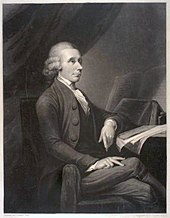
Polish alchemist, philosopher, and physician Michael Sendivogius (Michał Sędziwój) in his work De Lapide Philosophorum Tractatus duodecim e naturae fonte et manuali experientia depromti (1604) described a substance contained in air, referring to it as 'cibus vitae' (food of life,[14]) and according to Polish historian Roman Bugaj, this substance is identical with oxygen.[15] Sendivogius, during his experiments performed between 1598 and 1604, properly recognized that the substance is equivalent to the gaseous byproduct released by the thermal decomposition of potassium nitrate. In Bugaj's view, the isolation of oxygen and the proper association of the substance to that part of air which is required for life, provides sufficient evidence for the discovery of oxygen by Sendivogius.[15] This discovery of Sendivogius was however frequently denied by the generations of scientists and chemists which succeeded him.[14]
It is also commonly claimed that oxygen was first discovered by Swedish pharmacist Carl Wilhelm Scheele. He had produced oxygen gas by heating mercuric oxide (HgO) and various nitrates in 1771–72.[16][17][8] Scheele called the gas "fire air" because it was then the only known agent to support combustion. He wrote an account of this discovery in a manuscript titled Treatise on Air and Fire, which he sent to his publisher in 1775. That document was published in 1777.[18]
In the meantime, on August 1, 1774, an experiment conducted by the British clergyman Joseph Priestley focused sunlight on mercuric oxide contained in a glass tube, which liberated a gas he named "dephlogisticated air".[17] He noted that candles burned brighter in the gas and that a mouse was more active and lived longer while breathing it. After breathing the gas himself, Priestley wrote: "The feeling of it to my lungs was not sensibly different from that of common air, but I fancied that my breast felt peculiarly light and easy for some time afterwards."[11] Priestley published his findings in 1775 in a paper titled "An Account of Further Discoveries in Air", which was included in the second volume of his book titled Experiments and Observations on Different Kinds of Air.[8][19] Because he published his findings first, Priestley is usually given priority in the discovery.
The French chemist Antoine Laurent Lavoisier later claimed to have discovered the new substance independently. Priestley visited Lavoisier in October 1774 and told him about his experiment and how he liberated the new gas. Scheele had also dispatched a letter to Lavoisier on September 30, 1774, which described his discovery of the previously unknown substance, but Lavoisier never acknowledged receiving it. (A copy of the letter was found in Scheele's belongings after his death.)[18]
Lavoisier's contribution

Lavoisier conducted the first adequate quantitative experiments on oxidation and gave the first correct explanation of how combustion works.[17] He used these and similar experiments, all started in 1774, to discredit the phlogiston theory and to prove that the substance discovered by Priestley and Scheele was a chemical element.
In one experiment, Lavoisier observed that there was no overall increase in weight when tin and air were heated in a closed container.[17] He noted that air rushed in when he opened the container, which indicated that part of the trapped air had been consumed. He also noted that the tin had increased in weight and that increase was the same as the weight of the air that rushed back in. This and other experiments on combustion were documented in his book Sur la combustion en général, which was published in 1777.[17] In that work, he proved that air is a mixture of two gases; 'vital air', which is essential to combustion and respiration, and azote (Gk. ἄζωτον "lifeless"), which did not support either. Azote later became nitrogen in English, although it has kept the earlier name in French and several other European languages.[17]
Etymology
Lavoisier renamed 'vital air' to oxygène in 1777 from the Greek roots ὀξύς (oxys) (acid, literally "sharp", from the taste of acids) and -γενής (-genēs) (producer, literally begetter), because he mistakenly believed that oxygen was a constituent of all acids.[20] Chemists (such as Sir Humphry Davy in 1812) eventually determined that Lavoisier was wrong in this regard, but by then the name was too well established.[21]
Oxygen entered the English language despite opposition by English scientists and the fact that the Englishman Priestley had first isolated the gas and written about it. This is partly due to a poem praising the gas titled "Oxygen" in the popular book The Botanic Garden (1791) by Erasmus Darwin, grandfather of Charles Darwin.[18]
Later history
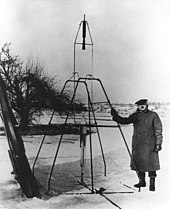
John Dalton's original atomic hypothesis presumed that all elements were monatomic and that the atoms in compounds would normally have the simplest atomic ratios with respect to one another. For example, Dalton assumed that water's formula was HO, leading to the conclusion that the atomic mass of oxygen was 8 times that of hydrogen, instead of the modern value of about 16.[22] In 1805, Joseph Louis Gay-Lussac and Alexander von Humboldt showed that water is formed of two volumes of hydrogen and one volume of oxygen; and by 1811 Amedeo Avogadro had arrived at the correct interpretation of water's composition, based on what is now called Avogadro's law and the diatomic elemental molecules in those gases.[23][a]
The first commercial method of producing oxygen was chemical, the so-called Brin process involving a reversible reaction of barium oxide. It was invented in 1852 and commercialized in 1884, but was displaced by newer methods in early 20th century.
By the late 19th century scientists realized that air could be liquefied and its components isolated by compressing and cooling it. Using a cascade method, Swiss chemist and physicist Raoul Pierre Pictet evaporated liquid sulfur dioxide in order to liquefy carbon dioxide, which in turn was evaporated to cool oxygen gas enough to liquefy it. He sent a telegram on December 22, 1877, to the French Academy of Sciences in Paris announcing his discovery of liquid oxygen.[24] Just two days later, French physicist Louis Paul Cailletet announced his own method of liquefying molecular oxygen.[24] Only a few drops of the liquid were produced in each case and no meaningful analysis could be conducted. Oxygen was liquefied in a stable state for the first time on March 29, 1883, by Polish scientists from Jagiellonian University, Zygmunt Wróblewski and Karol Olszewski.[25]

In 1891 Scottish chemist James Dewar was able to produce enough liquid oxygen for study.[26] The first commercially viable process for producing liquid oxygen was independently developed in 1895 by German engineer Carl von Linde and British engineer William Hampson. Both men lowered the temperature of air until it liquefied and then distilled the component gases by boiling them off one at a time and capturing them separately.[27] Later, in 1901, oxyacetylene welding was demonstrated for the first time by burning a mixture of acetylene and compressed O
2. This method of welding and cutting metal later became common.[27]
In 1923, the American scientist Robert H. Goddard became the first person to develop a rocket engine that burned liquid fuel; the engine used gasoline for fuel and liquid oxygen as the oxidizer. Goddard successfully flew a small liquid-fueled rocket 56 m at 97 km/h on March 16, 1926, in Auburn, Massachusetts, US.[27][28]
In academic laboratories, oxygen can be prepared by heating together potassium chlorate mixed with a small proportion of manganese dioxide.[29]
Oxygen levels in the atmosphere are trending slightly downward globally, possibly because of fossil-fuel burning.[30]
Characteristics
Properties and molecular structure

At standard temperature and pressure, oxygen is a colorless, odorless, and tasteless gas with the molecular formula O
2, referred to as dioxygen.[32]
As dioxygen, two oxygen atoms are chemically bound to each other. The bond can be variously described based on level of theory, but is reasonably and simply described as a covalent double bond that results from the filling of molecular orbitals formed from the atomic orbitals of the individual oxygen atoms, the filling of which results in a bond order of two. More specifically, the double bond is the result of sequential, low-to-high energy, or Aufbau, filling of orbitals, and the resulting cancellation of contributions from the 2s electrons, after sequential filling of the low σ and σ* orbitals; σ overlap of the two atomic 2p orbitals that lie along the O–O molecular axis and π overlap of two pairs of atomic 2p orbitals perpendicular to the O–O molecular axis, and then cancellation of contributions from the remaining two 2p electrons after their partial filling of the π* orbitals.[31]
This combination of cancellations and σ and π overlaps results in dioxygen's double-bond character and reactivity, and a triplet electronic ground state. An electron configuration with two unpaired electrons, as is found in dioxygen orbitals (see the filled π* orbitals in the diagram) that are of equal energy—i.e., degenerate—is a configuration termed a spin triplet state. Hence, the ground state of the O
2 molecule is referred to as triplet oxygen.[33][b] The highest-energy, partially filled orbitals are antibonding, and so their filling weakens the bond order from three to two. Because of its unpaired electrons, triplet oxygen reacts only slowly with most organic molecules, which have paired electron spins; this prevents spontaneous combustion.[34]
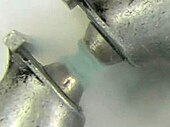
In the triplet form, O
2 molecules are paramagnetic. That is, they impart magnetic character to oxygen when it is in the presence of a magnetic field, because of the spin magnetic moments of the unpaired electrons in the molecule, and the negative exchange energy between neighboring O
2 molecules.[26] Liquid oxygen is so magnetic that, in laboratory demonstrations, a bridge of liquid oxygen may be supported against its own weight between the poles of a powerful magnet.[35][c]
Singlet oxygen is a name given to several higher-energy species of molecular O
2 in which all the electron spins are paired. It is much more reactive with common organic molecules than is normal (triplet) molecular oxygen. In nature, singlet oxygen is commonly formed from water during photosynthesis, using the energy of sunlight.[36] It is also produced in the troposphere by the photolysis of ozone by light of short wavelength[37] and by the immune system as a source of active oxygen.[38] Carotenoids in photosynthetic organisms (and possibly animals) play a major role in absorbing energy from singlet oxygen and converting it to the unexcited ground state before it can cause harm to tissues.[39]
Allotropes
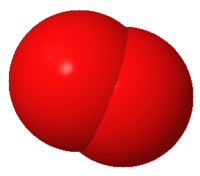
The common allotrope of elemental oxygen on Earth is called dioxygen, O
2, the major part of the Earth's atmospheric oxygen (see Occurrence). O2 has a bond length of 121 pm and a bond energy of 498 kJ/mol.[40] O2 is used by complex forms of life, such as animals, in cellular respiration. Other aspects of O
2 are covered in the remainder of this article.
Trioxygen (O
3) is usually known as ozone and is a very reactive allotrope of oxygen that is damaging to lung tissue.[41] Ozone is produced in the upper atmosphere when O
2 combines with atomic oxygen made by the splitting of O
2 by ultraviolet (UV) radiation.[20] Since ozone absorbs strongly in the UV region of the spectrum, the ozone layer of the upper atmosphere functions as a protective radiation shield for the planet.[20] Near the Earth's surface, it is a pollutant formed as a by-product of automobile exhaust.[41] At low earth orbit altitudes, sufficient atomic oxygen is present to cause corrosion of spacecraft.[42]
The metastable molecule tetraoxygen (O
4) was discovered in 2001,[43][44] and was assumed to exist in one of the six phases of solid oxygen. It was proven in 2006 that this phase, created by pressurizing O
2 to 20 GPa, is in fact a rhombohedral O
8 cluster.[45] This cluster has the potential to be a much more powerful oxidizer than either O
2 or O
3 and may therefore be used in rocket fuel.[43][44] A metallic phase was discovered in 1990 when solid oxygen is subjected to a pressure of above 96 GPa[46] and it was shown in 1998 that at very low temperatures, this phase becomes superconducting.[47]
Physical properties
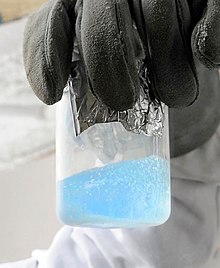
Oxygen dissolves more readily in water than nitrogen, and in freshwater more readily than in seawater. Water in equilibrium with air contains approximately 1 molecule of dissolved O
2 for every 2 molecules of N
2 (1:2), compared with an atmospheric ratio of approximately 1:4. The solubility of oxygen in water is temperature-dependent, and about twice as much (14.6 mg/L) dissolves at 0 °C than at 20 °C (7.6 mg/L).[11][48] At 25 °C and 1 standard atmosphere (101.3 kPa) of air, freshwater can dissolve about 6.04 milliliters (mL) of oxygen per liter, and seawater contains about 4.95 mL per liter.[49] At 5 °C the solubility increases to 9.0 mL (50% more than at 25 °C) per liter for freshwater and 7.2 mL (45% more) per liter for sea water.
| 5 °C | 25 °C | |
|---|---|---|
| Freshwater | 9.00 | 6.04 |
| Seawater | 7.20 | 4.95 |
Oxygen condenses at 90.20 K (−182.95 °C, −297.31 °F) and freezes at 54.36 K (−218.79 °C, −361.82 °F).[50] Both liquid and solid O
2 are clear substances with a light sky-blue color caused by absorption in the red (in contrast with the blue color of the sky, which is due to Rayleigh scattering of blue light). High-purity liquid O
2 is usually obtained by the fractional distillation of liquefied air.[51] Liquid oxygen may also be condensed from air using liquid nitrogen as a coolant.[52]
Liquid oxygen is a highly reactive substance and must be segregated from combustible materials.[52]
The spectroscopy of molecular oxygen is associated with the atmospheric processes of aurora and airglow.[53] The absorption in the Herzberg continuum and Schumann–Runge bands in the ultraviolet produces atomic oxygen that is important in the chemistry of the middle atmosphere.[54] Excited-state singlet molecular oxygen is responsible for red chemiluminescence in solution.[55]
Table of thermal and physical properties of oxygen (O2) at atmospheric pressure:[56][57]


